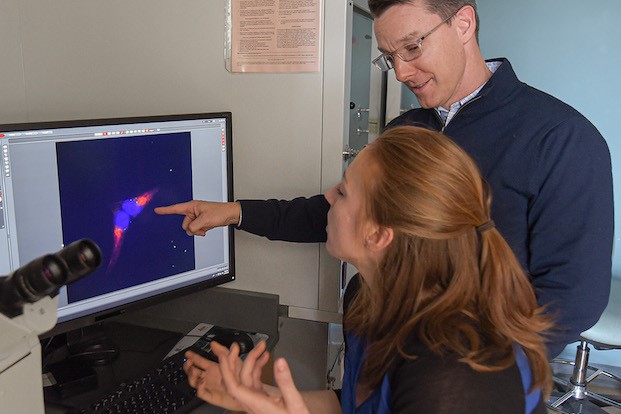Dr. Jason A. Carlyon selected for once-in-a-lifetime NIH MERIT award
With this prestigious award, Carlyon will receive up to 10 more years of continuous funding to support the development of a vaccine for human granulocytic anaplasmosis, the second most common tickborne disease in the United States.

Jason A. Carlyon, Ph.D., is a professor and researcher in the Department of Microbiology and Immunology. (Photo by DeAudrea 'Sha' Aguado, VCU School of Medicine)
When Department of Microbiology and Immunology Professor Jason A. Carlyon, Ph.D., submitted the renewal for his NIH R01 grant, he was hoping to receive five more years of funding to support his research into human granulocytic anaplasmosis, a potentially fatal infection and the second most common tickborne disease in the United States. Instead, the National Institute of Allergy and Infectious Diseases, or NIAID, not only decided to renew the grant for a third time but also nominated it for a Method to Extend Research in Time (MERIT) R37 award, which could provide an additional three to five years of funding.
According to NIAID, MERIT awards are intended to provide long-term, stable support to investigators with “stellar records of research accomplishment” and “outstanding productivity.” The institute issues about 15 new MERIT awards each year, and an investigator can usually only receive one during their lifetime.
“I am extremely thrilled and humbled at the same time,” said Carlyon, who earned his bachelor’s degree in biology from the College of Humanities and Sciences and his Ph.D. from the School of Medicine. “The fact that someone at NIAID selected me and an internal committee there looked at my body of work and thought it was good enough – it is a real culmination of 15-plus years. And I share it with each and every student and postdoc that I’ve ever worked with on this project. It’s a real honor.”
David Chelmow, M.D., interim dean of the VCU School of Medicine, emphasized the importance of Carlyon’s research.
“Tickborne illnesses in the U.S. have more than doubled during the past two decades, making the need for vaccines critical,” Chelmow said. “Jason and his lab have been on the forefront of innovations designed to help prevent human granulocytic anaplasmosis in both humans and animals for the last 15 years. This award highlights both the importance of this work and Jason’s leadership and impressive productivity in the field.”
Finding solutions to a growing problem
In 2019, 5,655 cases of granulocytic anaplasmosis were reported to the Centers for Disease Control and Prevention, a 16-fold increase since 2000. However, evidence indicates that many more cases go undocumented so the true incidence may be 10 to 50 times higher. This debilitating and potentially deadly disease, which is transmitted through deer tick bites, also is found in Europe and Asia and can affect dogs, cats, horses and sheep.
Since Carlyon received his first R01 in 2007, he and members of his lab have been investigating how Anaplasma phagocytophilum, the disease-causing bacterium, infects “accidental hosts” like humans, hijacking key immune cells called neutrophils to perpetuate its lifecycle.
“If we can understand how A. phagocytophilum invades and makes neutrophils its happy home, this would be the primary target for intervention,” Carlyon said. “Over the last five years, we have painstakingly teased out this process and used antibodies against the proteins we’ve identified to block Anaplasma invasion of cells in the lab. This research is a promising lead towards vaccine development against granulocytic anaplasmosis and is a blueprint for developing prophylactic and therapeutic approaches against other pathogens that infect cells using similar mechanisms.”
During the next five-year phase of this research, which will be supported by nearly $2.7 million from NIAID, Carlyon, co-investigator Richard T. Marconi, Ph.D., and their team are focused on how proteins they’ve identified on the surface of the bacterium and neutrophils interact.
“We think that A. phagocytophilum is essentially building a signaling platform on the surface of neutrophils that allows it to orchestrate its invasion,” Carlyon said. “If we can figure out what the linchpin is, we can design a protective approach to effectively target it, stopping Anaplasma’s ability to trick these immune cells.”
With the opportunity to extend federal funding for this project by an additional three to five years through a non-competitive MERIT extension grant, Carlyon is looking forward to devoting more focus to the science and mentorship and less to the grant writing process.
“That’s why I appreciate that NIH has this MERIT program because it gives people like me the opportunity to continue to test our hypotheses, generate more knowledge and recruit and train more scientists in our labs,” Carlyon said. “I’ll use the time with this MERIT award to really maximize what I and those in my lab can achieve. I want to honor it.”


